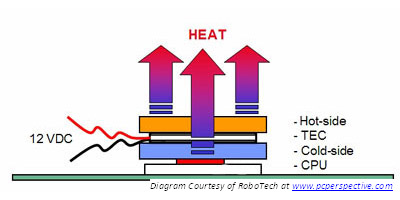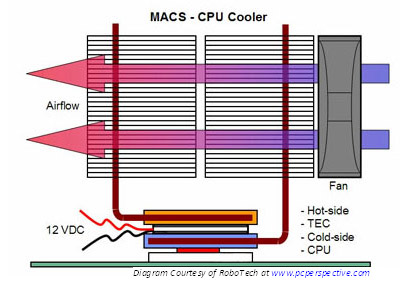Monsoon II Lite: Thermal Electric Cooling Tower
by Wesley Fink on February 6, 2007 6:00 AM EST- Posted in
- Cases/Cooling/PSUs
How the Monsoon II Lite Works
Thermal Electric Cooling is based on a very simple concept. When a low voltage DC current is applied to the junction of two connected dissimilar materials, heat can be moved from one material to the other. One side is cooled (cold plate) and the other side is simultaneously heated (hot side). The temperature differential between the sides can be upwards of 50°C, and the heatpipe/fins arrangement enhances cooling by creating a temperature differential that can be moved out of the system.

You may wonder why this simple concept is not used in every cooling device. It is because things are not as straightforward as they first appear. The cooling process itself is very inefficient, and the Peltier consumes more power than it produces in cooling. In fact it consumes two or three times more power than it delivers in cooling. Another major issue is that during idle and light loads the cool plate and the area around it may suffer from condensation and frost may form. This is one of the reasons phase-change cooling devices are heavily insulated (and expensive).
Another problem that needs to be addressed is the proper sizing of the TEC. If it is too small (low-wattage) it won't be able to keep up with the CPU heat generation; too large and it could rapidly overcool and frost over. Solid state devices like a TEC are very reliable, but another overriding concern is that if anything goes wrong, such as lost power to the Peltier or a broken wire, the Peltier stops pumping heat and becomes an insulator, which could cause a processor failure with no other cooling available.

Vigor believes they have eliminated these problems by combining a medium-power intermittent TEC with an efficient heatpipe cooling tower. The Monsoon II Lite isn't designed for extreme sub-zero overclocking. Instead it is designed as a high-performance Heatsink/Fan with a 25°C target temperature, which is a little higher than ambient room temperature. By limiting the maximum temperature by intermittent operation of the Peltier problems like condensation are no longer an issue.
In addition, the heatpipes are connected to both the cold and the hot plates. This provides Monsoon II an alternate heat-flow path from the vulnerable cold plate, and it protects the processor in the event of TEC failure. Finally, when processor load is light the Monsoon II can switch off the Peltier and simply rely on the heatpipe tower for cooling. When CPU demands are high the Peltier runs almost continuously, and in medium loads the TEC switches between on, half-power, and off to maintain the target temperature.
This hybrid of a TEC and a heatpipe tower will certainly not challenge the cooling of the extreme refrigerated phase-change coolers. However, it does offer the potential to outperform standard air and water cooling. With the Lite priced at $100 or less, it also offers the potential for better processor cooling without breaking the bank. At a street price of $89 the Monsoon II Lite is barely more than some of the top air coolers and cheaper than most of the water-cooling kits.
Thermal Electric Cooling is based on a very simple concept. When a low voltage DC current is applied to the junction of two connected dissimilar materials, heat can be moved from one material to the other. One side is cooled (cold plate) and the other side is simultaneously heated (hot side). The temperature differential between the sides can be upwards of 50°C, and the heatpipe/fins arrangement enhances cooling by creating a temperature differential that can be moved out of the system.

You may wonder why this simple concept is not used in every cooling device. It is because things are not as straightforward as they first appear. The cooling process itself is very inefficient, and the Peltier consumes more power than it produces in cooling. In fact it consumes two or three times more power than it delivers in cooling. Another major issue is that during idle and light loads the cool plate and the area around it may suffer from condensation and frost may form. This is one of the reasons phase-change cooling devices are heavily insulated (and expensive).
Another problem that needs to be addressed is the proper sizing of the TEC. If it is too small (low-wattage) it won't be able to keep up with the CPU heat generation; too large and it could rapidly overcool and frost over. Solid state devices like a TEC are very reliable, but another overriding concern is that if anything goes wrong, such as lost power to the Peltier or a broken wire, the Peltier stops pumping heat and becomes an insulator, which could cause a processor failure with no other cooling available.

Vigor believes they have eliminated these problems by combining a medium-power intermittent TEC with an efficient heatpipe cooling tower. The Monsoon II Lite isn't designed for extreme sub-zero overclocking. Instead it is designed as a high-performance Heatsink/Fan with a 25°C target temperature, which is a little higher than ambient room temperature. By limiting the maximum temperature by intermittent operation of the Peltier problems like condensation are no longer an issue.
In addition, the heatpipes are connected to both the cold and the hot plates. This provides Monsoon II an alternate heat-flow path from the vulnerable cold plate, and it protects the processor in the event of TEC failure. Finally, when processor load is light the Monsoon II can switch off the Peltier and simply rely on the heatpipe tower for cooling. When CPU demands are high the Peltier runs almost continuously, and in medium loads the TEC switches between on, half-power, and off to maintain the target temperature.
This hybrid of a TEC and a heatpipe tower will certainly not challenge the cooling of the extreme refrigerated phase-change coolers. However, it does offer the potential to outperform standard air and water cooling. With the Lite priced at $100 or less, it also offers the potential for better processor cooling without breaking the bank. At a street price of $89 the Monsoon II Lite is barely more than some of the top air coolers and cheaper than most of the water-cooling kits.










19 Comments
View All Comments
nickfd - Tuesday, February 6, 2007 - link
Can you post a review/link to review for this cooler?Wesley Fink - Tuesday, February 6, 2007 - link
The Freezone is in our testing calendar and it will definitely be compared to the Monsoon II Lite.jvuser - Tuesday, February 6, 2007 - link
It is not recommended to run TEC/peltiers by thermostatic switching. This leads to excessive stresses and preliminary failure. See datasheets at www.marlow.com.DrMrLordX - Tuesday, February 6, 2007 - link
Reviews I've seen of the original Vigor Monsoon II seem to reflect your findings, except:1). The Monsoon II works much better when modded to work with a better 92mm fan (not easy to do)
2). The Monsoon II works better in cases with good airflow
You didn't mention the case or case fans used, and you barely showed a picture of the test system. Could you please elabourate on the airflow situation in which you tested the Monsoon II? Also, are you able to include a Titan Amanda in your test as well?
It is good that the Monsoon II will now be available at a lower price.
RobFDB - Tuesday, February 6, 2007 - link
From your results the only advantage the Monsoon II Lite seems to give the EU is maybe 60 more mhz. Aside from that it costs more than the Tuniq 120, it doesn't cool as well, it adds 50w of power to your overall consumption and it's noisier. Sure it's an innovative idea, but it doesn't actually help out the EU.Jodiuh - Tuesday, February 6, 2007 - link
Exactly what I wanted to say. I'm one of those "will give up OC for a nice quiet room" guys. And I actually replaced the Tuniq fan w/ a Scythe SFLEX. :DSurJector - Tuesday, February 6, 2007 - link
I totally agree as well. Additionally the sentenceis incorrect: the air cooler has to cool 49 more W. If the processor consumes 150W and the Peltier element 49W (leaving 1W for the fan), then the radiator has 199W to cool down instead of 150W. It is very tricky to cool down a Peltier element without noise. In that case, I would say that they did not succeed: the processor is warmer and the fan noisier. The additional 60MHz (i.e. 1.5%) look insignificant, at least to me.
Wesley Fink - Tuesday, February 6, 2007 - link
The noise level with the TEC and fan running at full speed is still much lower than the stress sound levels we measured. Most of the added noise is the buzzing, pops, and clicks from the fan being controlled simultaneously with the TEC. As we said in the review the fan running continously is much quieter.Vigor says they are aware of the issues and they are working to separately control the fan and TEC with the controller. This will definitely reduce noise levels.
DigitalFreak - Tuesday, February 6, 2007 - link
I totally agree. While it's a novel idea, the only plus it has over the Tuniq 120 is an extra 60Mhz overclock. When I get my C2D or C2Q system, I'm going with the Tuniq.